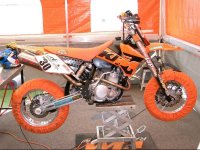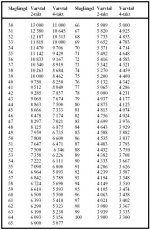Barrett skrev:
Ngn som sitter på instruktioner på hur ljudmätningen ska utföras. Mått, vinkel, kolvhastighet osv.
Jag har försökt att hitta det hos Svemo utan att lyckas. Men som det verkar så skall ju svenska reglementet i mångt och mycket vara en översättning av det internationella då borde ju rimligen det FIM skriver vara hyfsat nära sanningen. Blev lite mycket men vad FIM skriver är:
01.79 SOUND CONTROL
Sound will be controlled to limits as stated in Art. 79.11.
79.01
With the microphone placed at 50 cm from the exhaust pipe at an angle of 45° measured from the centre-line of the exhaust end and at the height of exhaust pipe, but at least 20 cm above the ground. If this is not possible, the measurement can be taken at 45° upwards.
79.02
During the sound test only, every motorcycle must be equipped with an extension (min. 30 cm) to the spark plug cable, if requested by the Chief Technical Steward. One end of this extension must be plugged into the original spark plug cap whilst the other end has another spark plug cap and fitted normally on the spark plug.
During a sound test, machines not equipped with a gear box neutral must be placed on a stand. During the sound test, only the rider may take place on the machine in the normal riding position and operate the throttle. No other team personnel may influence the sound test.
79.03
The silencers will be marked when they are checked and it is not allowed to change them after the verification, except for any spare silencer which has also been checked and marked.
79.04
The rider shall keep his engine running out of gear and shall increase the engine speed until it reaches the specified Revolutions Per Minute (RPM). Measurements must be taken when the specified RPM is reached.
79.05
The RPM depends upon the mean piston speed corresponding to the stroke of
the engine.
The RPM will be given by the relationship :
N = 30,000 x cm / l
in which
N = prescribed RPM of engine
cm = fixed mean piston speed in m/s
l = stroke in mm
79.06
The piston speed for Motocross (13m/s) is only an equivalent approximate figure, for reference only. For convenience, made possible by the similarity of engine stroke on current Motocross machines, within capacity classes, the test will be conducted at a fixed RPM :
Up to 85 cc 8,000 RPM
Over 85 cc up to 125 cc 7,000 RPM
Over 125 up to 250 cc 5,000 RPM
Over 250 cc up to 500 cc 4,500 RPM
Over 500 cc 4,000 RPM
79.07
The sound level for engines with more than one cylinder will be measured on each exhaust end.
79.08
A machine which does not comply with the sound limits can be presented several times at pre-race control.
79.11 Sound limits in force
98 dB/A (see also Art. 79.06).
As from 01.01.2006: 96 dB/A
79.12
The surrounding sound should not exceed 90 dB/A within a 5 metres radius from the power source during tests.
79.13
Apparatus for sound control must be to international standard IEC 651, Type 1 or Type 2.
The sound level meter must be equipped with a calibrator for control and
adjustment of the meter during periods of use.
79.14
The "slow response" setting must always be used.
79.15
Due to the influence of temperature on sound tests, all figures are correct at 20°C. For tests taken at temperatures below 10° C there will be a + 1 dB/A tolerance. For tests below 0°C, a + 2 d/BA tolerance.
79.16 Sound control during and after the competition
In a competition which requires a final examination of machines before the results are announced, this examination must include a sound control measurement of at least three machines chosen at the discretion of the Clerk of the Course in co-operation with the Chief Technical Steward
01.80 GUIDELINES FOR USE OF SOUND LEVEL METERS
80.01
The Sound Control Officer (NCO) must arrive in sufficient time for discussions with the Clerk of the Course and other Technical Officials in order that a suitable test site and testing policy can be agreed.
80.02
Sound level measuring equipment must include a compatible calibrator, which must be used immediately before testing begins and always just prior to a re-test if a disciplinary sanction may be imposed. Two sets of equipment must be available in case of failure of tachometer, sound level meter or calibrator during technical control.
80.03
Before testing, the NCO should if possible liaise with a maximum of two holders of FIM Entrant's or Manufacturer's licences, or team managers, who have sound test equipment including calibrators, in order to agree the accuracy of the official sound level meter.
80.04
Tests should not take place in rain or excessively damp conditions. Machines considered excessively noisy must be individually tested if conditions allow.
80.05
In other than moderate wind, machines should face forward in the wind direction. (Mechanical sound will blow forward, away from microphone).
80.06
'Slow' meter response must be used.
80.07
'A' weighted setting on sound level meter.
80.08
Always round down meter reading, that is : 100.9 dB/A = 100 dB/A.
80.09 Corrections
Type 1 meter : deduct 1 dB/A
Type 2 meter : deduct 2 dB/A
80.10 Temperature
Ambient temperature :
Below 10° Celsius : deduct 1 dB/A
Below 00° Celsius : deduct 2 dB/A.
All tolerances are accumulative. Action taken will depend on the sporting discipline concerned, and decisions taken during prior discussions with the clerk of the Course.
Hela dokumentet hittar du under Technical Rules på sidan
http://www.fim.ch/en/default.asp?item=27#
.
Speciellt hatar jag de där jäkla YZ450F.


















